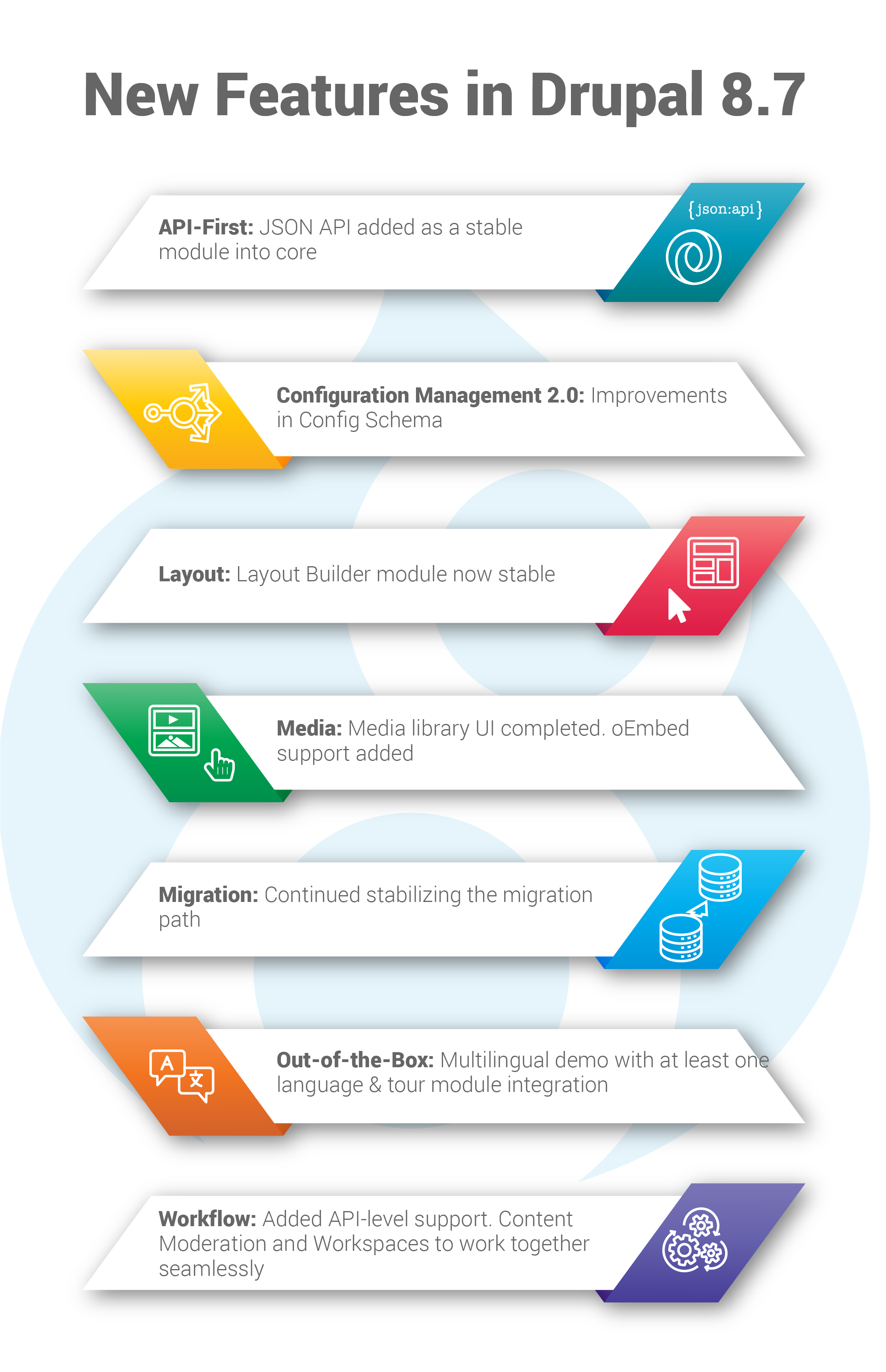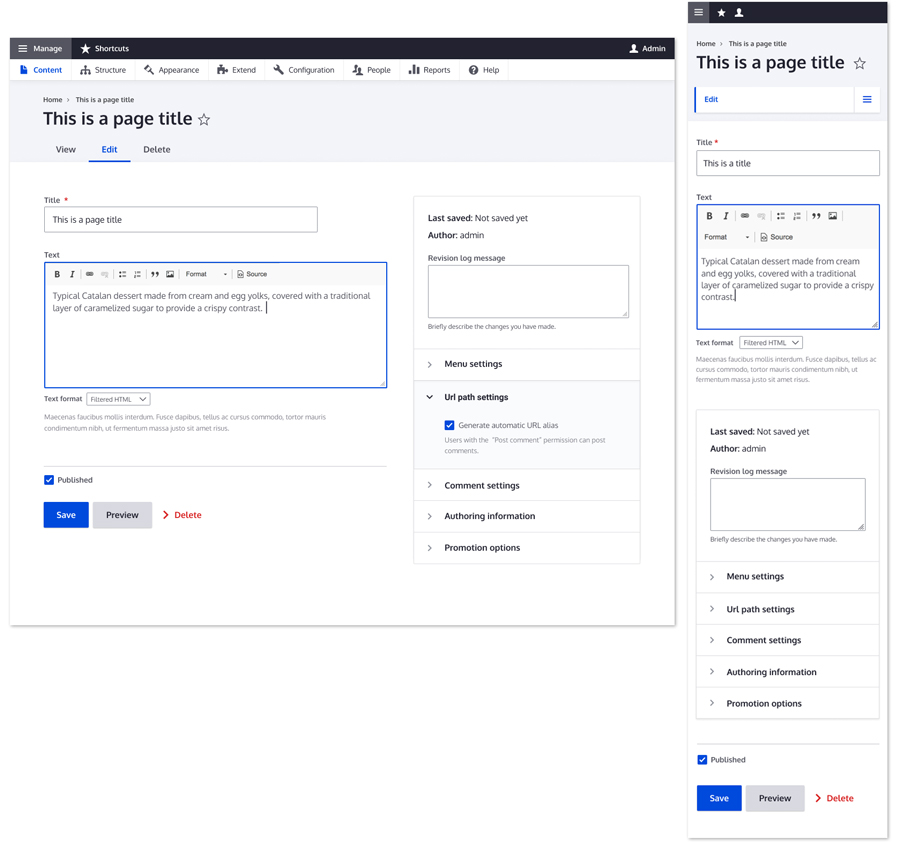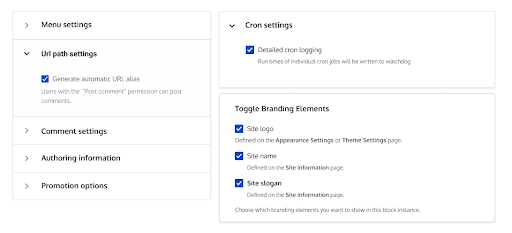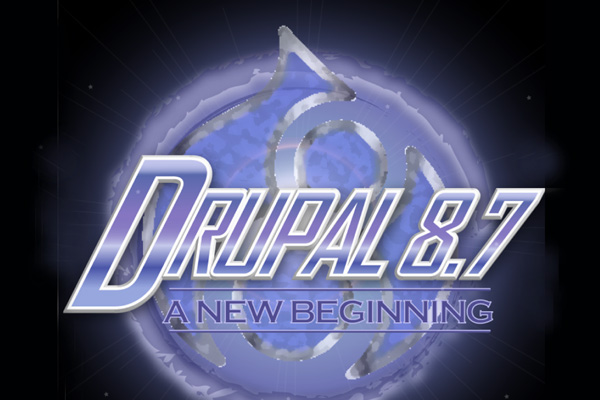Web development has moved forward from writing websites by developing codes to a place where people can assemble the websites. And that is where the Drupal community is focusing on to advance - building assembled web experiences.
Drupal 8.7 releases today, on 1 May. It is in sync with that same roadmap (building assembled websites) providing enhanced customization, stable features, better UI and what not?
Here’s a quick and comprehensive guide for you to track what’s new in version 8.7 and how it paves the way for Drupal 9.
Drupal 8.7 Features and Updates
This is a significant update. It brings with it a stable Layout builder and Media Library, JSON API at the core, tour integration, seamless working of Content Moderation and Workspaces together, and a continued stabilized migration path.
Drupal 8.7 update retains the relevance in the emerging world of web technologies and competition. Riding on its API capabilities, new changes are aimed to be user-friendly.
Here’s a look at the host of features it brings along.
-
JSON:API at Core
The update brings with it JSON:API at the core, marking another milestone towards making Drupal API-first. API-first means using the flexibility of Drupal to integrate it with other systems and be able to use content anywhere, display as you please.
Content creators can, now, create their content models without having to write a single line of code.
JSON:API module for Drupal 8 in action
The JSON:API module is meant for creating high-performance APIs to expose Drupal data in JSON. It works by creating API endpoints and requires no configuration and the module instantly accesses all Drupal entities.
Developers and content creators, now, can create their content models without having to write a single line of code. It not only provides a great authoring experience but also a powerful, standards-compliant, web service API to pull that content into JavaScript applications, digital kiosks, chatbots, voice assistants and more.
This makes it easier for Drupal’s core ecosystem, of web services responsible for third-party content and application, to integrate. -
Stable Layout Builder
Released in 8.6 as an experimental module, Layout Builder is stabilized in Drupal 8.7 update. The module allows you to build layouts with ready-to-use multi-column layouts and Drupal blocks without the intervention of a developer.
It is unique since it can support multiple and different use cases from templated layouts applied to dozens of pieces of structured content, to designing custom one-off pages with unstructured content.
Drupal Layout Builder in action
Here’s how it can be used in three different use cases:
- Layouts for templated content: The creation of ‘layout templates’ can be used for a specific content type. Example, blog posts.
- Customizations to templated layouts: Can customize the layout templates on a case-by-case basis. Example, to override the layout of a standardized product page.
- Custom pages: The creation of custom landing pages which are not in sync to any particular content type or structured content. Example, a single ‘About us’ page.
The Layout Builder is more powerful when used with Drupal's other out-of-the-box features such as revisioning, content moderation, and translations.
-
Workflow
The workflow module enables you to create arbitrary workflows in Drupal and associate them with entities.
The support for more revisionable properties would allow the staging of both content and associated properties
However, taxonomy terms were not revisionable.
The main issue with non-revisionable terms is site-wide previews of not yet published content (nodes, media items, taxonomy terms, menu links, etc.), through the Workspaces module.
Taxonomy terms are now revisionable using the new API. This comes as part of the Entity system that helps retrieve an entity for converting the schema of a content entity type from non-revisionable/ non-translatable to revisional/translatable.
This works well with other pre-existing data for the entity type whose schema has been changed and comes handy with content revisioning. The support for more revisionable properties would allow the staging of both content and associated properties.
EntityDefinitionUpdateManage is now deprecated with no replacement.
At the moment core only supports sequential revisioning, parallel revisioning support will be added in 8.8. -
Media Library
Shipped as an experimental module in 8.6, Media library is now stabilized and good to use.
It provides a visually appealing interface for browsing through all the media items in your site. With the new version, multimedia properties can be added to content either by selecting from existing media or by uploading new media through bulk upload support. Once uploaded, users can remove or reorder any images ready for import.
Media Library in Drupal 8.7
It provides an easy way to upload several media assets in your Drupal website quickly. Let’s you add alt-text, check the images before uploading.
Powered by Views, it allows site builders to customize the display, sorting, and filtering options. -
Configuration Management
The configuration management system in Drupal 8 is quite decent and allows configuration to be synced between installations of the same site in different environments. Configuration Management is part of the Configuration Management 2.0 Initiative which aims to include core support for extended workflows.
The current workflow presumes that the configuration will be exactly the same in different environments. Developers have to edit the configuration when it is not present.
The idea behind CM 2.0 is to the use case of sharing reusable packages of configuration among multiple sites
The major drawback which comes as an API for both the DX and API architecture is:
It allows modifying the sync storage as it is manipulated but since it has no concept of intent, the developer has to know which methods are called in which order of both the import and export process to correctly interact with it.
Configuration Management 2.0 in version 8.7 allows the altering and importing the configuration. The idea is to the use case of sharing reusable packages of configuration among multiple sites is on (at least!) a fully equal footing with that of staging configuration on a single site.
This allows the site administrator to review and safely import available configuration updates from installed modules, themes, and the install profile without overriding customizations made on the site. With 8.7 it can add the ability to select and use an existing configuration directory or storage at install time.
Configuration Transformer API as the fundamental cornerstone has been added to bulk update configuration. It makes it easier for configuration on dev to be different from production
New/expanded configuration management UIs for the issues (mentioned above) added to par with a new-to-Drupal site maintainer persona in mind. Experimental module for allowing environment-specific configuration has been introduced in 8.7.
And Drupal 9 readiness...
In order to give people reasonable upgrade time from Drupal 8 to Drupal 9, Drupal 9 will be released no later than a year before Drupal 8 goes end of life, that is in 2020.
Also, Drupal 9.0 is skipped, as it's intended to be only deprecated code removals, no new capabilities.
Other Important Information
Some other important information to take note of, are:
-
Removed support for PHP 5
Drupal 8.7 would no longer support the obsolete versions of PHP. Version 5.5 reached the end of life in 2016 and 5.6 in December 2018 meaning it no longer receives bugfixes, even for very serious bugs that (might) impact Drupal development. Moving forward Drupal encourages to use PHP V.7 or above.
Since Drupal 8's automated tests require the PHPUnit library, continued use of obsolete version can put security at risk. -
End of support for Internet Explorer 9
Due to a limit of 31 style sheets per page, Drupal dropped support for Internet Explorer 9 and 10 in 8.4. Since Drupal 8.5 and 8.6 retained a workaround to allow 32 or more stylesheets, this workaround has been removed in 8.7.
Sites dependent on Internet Explorer 9 support should enable CSS aggregation (preferred) or install the IE9 Compatibility contributed module. -
Better Symfony 4 and 5 compatibility
Drupal 8.7 will provide better compatibility with both Symfony 5 and Symfony 4 for faster web development, since Symphony 3 enters the end of life in November 2021. This includes changes in the Container and Translator Interface Symfony components, as well as resolving critical compatibility issues.
Additionally, numerous critical Symfony 4 and 5 compatibility issues are resolved in this release.
What to expect from Drupal 8.8?
Here’s what you need to look forward to in Drupal 8.8.
- The Welcome Tour
Adding Tour content for those unfamiliar with Drupal. This would help to teach people Drupal with hands-on experience, explaining backend/frontend choices made to build Umami. - Composer Support in Core
Involves making an official method for starting a Drupal site with the composer kickstart template. - Admin UI and Javascript Modernization
The new admin theme is part of the Admin UI and JS modernization initiative and will be released with Drupal 8.8.
The goal is to create and update the admin look, that defines a complete set of principles while also consisting of visual and behavioural components to combine into a user-friendly interface.
This will be based mostly on Seven’s styles theme.
 The navigation pages on the admin UI has been designed with an emphasis on readability, and reusability of existing styles from other components.
The navigation pages on the admin UI has been designed with an emphasis on readability, and reusability of existing styles from other components. Mockup of the interface with text written using the Devanagari writing system
Mockup of the interface with text written using the Devanagari writing system
This would come with various benefits, including improved performance and better support for various writing systems. Using system fonts will also make the UI feel more familiar to the user since it will be closer to the users' environment.
Drupal 8.8 Feature Freezes: October 2019
Drupal 8.8 Releases: December 2019
With Drupal’s commitment to reinventing itself to enable ambitious digital experiences, the community is getting ready for the launch of Drupal 9, and current updates are well in sync with it.
Have questions about Drupal 8 features or 9 and how it might impact you? Already chalking out an upgrade plan? Our team of Drupal experts and range of Drupal development services are ready to help.
Drop us a line at business@srijan.net, and get the conversation started.
Srijan is Signature Supporting Partner to the Drupal Association. With 140+ seasoned Drupalers of which 56+ are Acquia Certified, Srijan has the largest team of Drupal experts in Asia.
Our Services
Customer Experience Management
- Content Management
- Marketing Automation
- Mobile Application Development
- Drupal Support and Maintanence
Enterprise Modernization, Platforms & Cloud
- Modernization Strategy
- API Management & Developer Portals
- Hybrid Cloud & Cloud Native Platforms
- Site Reliability Engineering




